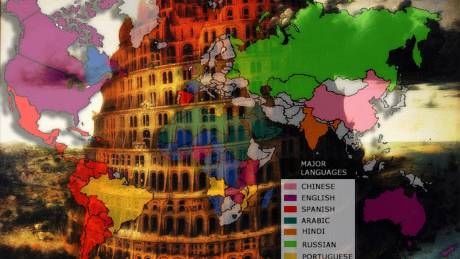Linguists seek a time when we spoke as one
Source: usatoday.com

A controversial research project is trying to trace all human language to a common root.
Around 50,000 years ago, something happened to our ancestors in Africa. Anatomically modern humans, who had existed for at least 150,000 years prior, suddenly began behaving differently. Until then, their conduct scarcely differed from that of their hominid cousins, the Neanderthals. Both buried their dead; both used stone tools; and as social apes, both had some form of communication, which some think was gestural.
But then, "almost overnight, everything changes very rapidly," says Merritt Ruhlen, a lecturer in the Anthropological Sciences Department at Stanford University in Palo Alto, Calif. Humans began making much better stone tools. They started burying their dead with accouterments that suggested religion. And perhaps most telling, Homo sapiens, the "wise" apes, began creating art.
"People started having imagination at this time much more than they had earlier," says Dr. Ruhlen.
Many scientists think that fully modern human language enabled this "great leap forward." Language enabled abstract thought, the deciding factor in archaic humans becoming – well, us. And because scientists surmise that language arose only once, they believe that before leaving Africa to colonize the world, all humankind spoke one language. Linguists have dubbed it "proto-world" or "proto-sapiens."
A multidisciplinary team of scientists at the Santa Fe Institute in New Mexico is working toward reconstructing that mother of all languages. Headed by Nobel Laureate physicist Murray Gell-Mann, the international Evolution of Human Languages (EHL) project is developing a freely accessible etymological database of the world's languages. Where possible, EHL linguists are attempting to reconstruct – and then compare – ancestor languages, moving ever closer to the first human language. Viewed by many linguists as a fringe movement, the project has attracted much criticism. Many linguists say that historical languages cannot be studied beyond an 8,000-year threshold; they change too much, they say. Some take issue with the project's methods: A few words shared among reconstructed languages doesn't prove a familial relationship, they insist, especially far back in time.
Languages change constantly. Speakers invent or borrow words to suit their needs. But for reasons not completely understood, some languages change more than others. Italian, for example, has remained much closer to ancestral Latin than French. Lithuanian has many words that almost exactly match Sanskrit, which was spoken 3,500 years ago. And some language "families" like Afroasiatic retain words in common even after more than 10,000 years of divergent evolution.
"That time limit is totally wrong," says John Bengtson, vice president of the Association for the Study of Language in Prehistory in Cambridge, Mass. "Languages that have been separated 8,000 years get down to a low percentage of common words. However, that low percentage seems to be very stable."
And there begins EHL's approach. Within languages, linguists think that because certain words – including the pronoun "we" and the number "one" – form the basis of a functional language, they are much less likely to change or be lost. EHL linguists begin by comparing this "basic lexicon." They include "words that are thoroughly essential and must have been in human language before significant cultural advances were made," writes EHL team member George Starostin, a linguist at the Russian State University for the Humanities in Moscow, in an e-mail.
Using this method, EHL has grouped all the world's languages into 12 linguistic superfamilies. They've tentatively grouped four of these superfamilies, which include languages of Eurasia, North Africa, and some Pacific islands (and maybe languages of the Americas as well) into one super-superfamily dubbed "Borean." An ancestor to a large share of today's languages, Borean was spoken some 16,000 years ago when glaciers covered much of Europe and North America, they say.
EHL linguists use several methods. One – the most controversial, but not the most widely used, says Starostin – involves matching words and meanings across languages. For example, Ruhlen and Bengtson have noticed that a word roughly corresponding to "water," which they render in proto-sapiens as "AQWA," appears in many languages. In Latin it's "aqua"; in Japanese, "aka" means "bilge water"; in Chechen, meanwhile, "aq" means "to suck"; in an African Kung dialect, "kau" means "to rain"; and in Central American Yucatec, "uk" means "to be thirsty."
But critics look at etymologies like these and see only problems. They're too loose with meanings and sounds, they say. And too many alternate explanations exist: Maybe the word was borrowed from one language and spread to the others. Perhaps it's onomatopoetic, a word that sounds like what it is. ("Cock-a-doodle-doo" is an onomatopoetic word that appears in similar form in many languages, but that doesn't prove relation.) Finally, the shorter the word – in some of the languages, just one syllable rather than two or three – the greater the possibility of a chance match.
"You've presented this list of words, but it looks like you can explain these lists in several different ways," says Lyle Campbell, a professor of linguistics at the University of Utah in Salt Lake City. "Their data is really easy to challenge, and it's really easy to find words that are similar to one another across languages."
EHL linguists argue that they're only doing exactly what Sir William Jones, who first postulated a common ancestor for classical Greek, Latin, and Sanskrit, did in the 18th century. (Indo-European, the eventual result of Jones's initial observations, is perhaps the most widely accepted language family.) Historical linguistics begins by observing similarities that occur more frequently than dictated by chance, they say – and they're just starting.
The comparison to Jones also underscores another argument central to EHL's endeavor. The further one moves back in time, the more related languages should resemble one another, they believe. "It is more risky because you're comparing two or more hypotheticals to arrive at an even more hypothetical construction," says Mr. Bengtson, "but we think it's still a valid thing to try to do."
Human genetic evidence appears to support EHL's basic assumptions. The human genome indicates that all humanity traces its ancestry to as few as 1,000 individuals who lived between 50,000 and 60,000 years ago. This small founding population may explain how the capacity for language spread so quickly. "Bottlenecks play a very important part in human evolution," says Ruhlen. "This was the first major bottleneck."
Genetics also suggests two separate migrations out of Africa. One followed the south coast of Asia, ending up in Australia at least 45,000 years ago. The other took the land route through the Middle East into Central Asia, where they went both west into Europe and east, eventually reaching the Americas.
Very tentatively, EHL has grouped the world's languages into three super-superfamilies corresponding to these migrations: those that correspond with the coastal route, which include Papuan languages; those that correspond with the land route out of Africa, descendants of Borean, the best reconstructed; and the "click" languages spoken by the San, or "Bushmen," of southern Africa. Scientists think that the San most resemble the first modern humans. Their language, almost unique in its use of click sounds that perhaps other early languages lost, may best conserve traces of proto-sapiens.
Recently, EHL further refined its hypothesis. How could the 16,000-year-old Borean have engendered the lion's share of Eurasian, North African, and American languages? Some 20,000 years ago, at the peak of the last ice age, the world lost much of its linguistic diversity, they argue. Advancing glaciers pushed humanity south, mashing linguistic groups together. As in later periods of human history – like now – only a few languages emerged from that mixing. Borean, they say, was one of them.
Copyright 2007 Christian Science Monitor
Article from: Linguists seek a time when we spoke as one






















